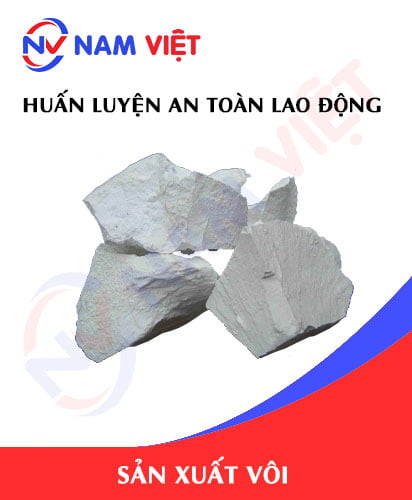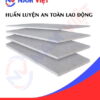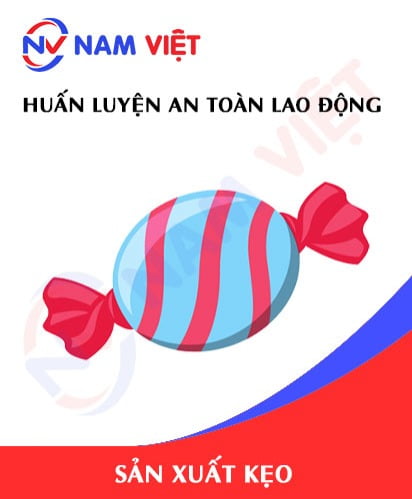Occupational safety training for lime manufacturing
99,000 ₫
Note: The above price is calculated per person, the price may fluctuate depending on the number of learners participating in the course and the market movement, for more accurate price support please refer to the pricing table or contact our consultants directly.
Occupational safety is an important issue in factories manufacturing lime and needs to be addressed promptly to ensure the health and safety of workers, enhancing the reputation of businesses. The Safety training course is one of the effective solutions to raise awareness about how to prevent occupational accidents for workers involved in manufacturing lime.
Table of Contents
Toggle1. Overview of lime
a. What is lime?
- Lime Powder is a fine powdered substance, produced from the calcination of limestone at a high temperature of about 900-1000 degrees Celsius. When limestone is heated, waste will decompose into CO2 gas and the remaining CaO (calcium oxide). Subsequently, calcium oxide will be processed to become lime powder.
- Lime powder has many applications in industries such as cement manufacturing, fertilizers, paints, ceramics, aquaculture, pesticides, water treatment, and construction. Additionally, lime powder is also used to improve soil in agriculture, ponds, lakes, waste treatment, and to reduce acidity in water.
- Lime powder has high alkalinity and can be highly corrosive and irritating to the skin and eyes, so it must be used and handled properly to ensure human health and safety.

b. Types of machinery for lime manufacturing
The types of machinery involved in lime manufacturing include:
- Crusher: This machine is used to crush limestone into smaller particles, suitable for the lime manufacturing process.
- Kiln: The kiln is used to burn limestone at a high temperature of about 900-1000 degrees Celsius, producing calcium oxide and other generated gases.
- Grinder: The grinder is used to grind lime into a fine powder, while also removing debris and impurities.
- Bagging machine: The bagging machine is used to pack lime powder into PP or kraft paper bags.
- Sieve: The sieve is used to separate lime powder into different sizes, thus meeting customer needs.
- Packaging machine: The packaging machine is used to pack the lime powder product into PP or kraft paper bags and move them into storage.
In addition, the lime manufacturing process also involves auxiliary equipment such as conveyor belts, air compressors, loading compressors, water pump systems, and a system for recovering and treating exhaust gases… to ensure the operation of the entire manufacturing process.

c. Lime manufacturing companies in Vietnam
In Vietnam, there are many lime manufacturing companies. Below are some of the large lime manufacturing companies in Vietnam:
- Mien Dong Lime Vietnam Joint Stock Company
- Thai Binh Construction and Building Materials Joint Stock Company)
- Thanh Thuy Lime Co., Ltd.)
- Binh Dinh Building Materials and Minerals Joint Stock Company
- Hoa Binh Construction and Trading Investment Joint Stock Company
- An Tuong Lime Co., Ltd.
- Dai Loc Building Materials and Minerals Co., Ltd.
- Nam Thanh Building Materials and Trading Co., Ltd.
- Thang Long Mineral and Construction Joint Stock Company
- Indochina Building Materials Joint Stock Company.
These businesses manufacture and supply lime powder and other lime products for construction projects, as well as other industries in Vietnam.
d. Specific jobs in a lime manufacturing factory
Group 1
- General director, deputy general director, department head in the lime manufacturing factory.
Group 2
- Safety officer: manages safety in the factory, designs safety procedures, supervises and urges employees to comply with safe work procedures.
Group 3
- Limestone extraction: Workers use machinery to extract limestone from quarries.
- Limestone transportation: After extraction, limestone is transported to storage rooms for manufacturing.
- Limestone crushing: Workers use a crusher to grind limestone into powder.
- Lime storage: Lime powder is stored in bunkers to ensure the quality and moisture of the product.
- Lime cleaning: Lime powder is cleaned by removing impurities and other foreign materials.
- Lime sifting: After cleaning, lime powder is sifted to ensure particle size and purity.
- Lime drying: Lime powder is put into a drying kiln to remove moisture and increase the durability of the product.
- Lime packing: Lime powder is packed into bags and transferred to storage or delivered to customers.
- Maintenance and cleaning: Machinery and equipment are periodically maintained to ensure the stability and efficiency of the manufacturing process. Cleaning is also an important part of ensuring the safety of employees and products.
- Quality control: Lime products are periodically quality checked to ensure they meet the set quality standards.
Group 4
- Jobs in the office, service, sales, and marketing.
- Production management, quality management, human resource management, material management, financial accounting management.
- Research and development of new products, packaging design.

2. Overview of occupational safety training for lime manufacturing
Within the scope of this article, we focus on issues related to Group 3, because Group 3 is the group directly involved in the manufacturing process, bearing the highest risk of occupational accidents. See more about other groups here
a. What is Group 3 occupational safety training?
- Occupational safety training for Group 3 are sessions that provide awareness on how to prevent occupational accidents for employees.
- The occupational safety training course will help employees recognize and avoid dangers, and limit the risks of occupational accidents while working.
REGISTER FOR OCCUPATIONAL SAFETY TRAINING SERVICES
b. Training duration
Initial safety training duration
- The total training duration is at least 24 hours, including the time for testing.
- 8 hours of theoretical study on the system of policies and laws on occupational safety and health
- 8 hours of theoretical study on basic knowledge of occupational safety and health
- 4 hours of theoretical study on specialized training content
- 2 hours of practical training on specialized training content
- 2 hours of theoretical testing at the end of the training course
The safety training center will divide the time into several training sessions depending on the time arrangement for employees. However, there are usually 6 training sessions, and the course will last for 3 days, provided that the manufacturing company can arrange continuous study time.
Periodic safety training duration
- Before the safety card expires, if employees want to have it reissued, they must undergo a periodic occupational safety training course, with the periodic safety training duration being at least 50% of the initial safety training duration.
Explanation: The total duration of periodic occupational safety training is at least 12 hours, including the time for testing. After completing the periodic training course and passing the test, the employee will be re-issued or have their safety card renewed.
c. Content of the training course
| No. | TRAINING CONTENT | TRAINING DURATION (HOURS) | |||
| Total | Of which | ||||
| Theory | Practical | Test | |||
| I | System of policies and laws on occupational safety and health | 8 | 8 | 0 | 0 |
| 1 | Overview of the system of legal normative documents on occupational safety and health. | 6 | 6 | ||
| 2 | System of technical standards and regulations on occupational safety and health. | 1 | 1 | ||
| 3 | Specific regulations of state management agencies on occupational safety and health when newly building, expanding, or renovating works, facilities for manufacturing, using, preserving, storing, and inspecting machinery, equipment, materials, and substances with strict requirements for occupational safety and health. | 1 | 1 | ||
| II | Basic knowledge of occupational safety and health | 8 | 8 | 0 | 0 |
| 1 | Basic knowledge of dangerous and harmful factors at the workplace. | 4 | 4 | ||
| 2 | Methods for improving working conditions. | 1 | 1 | ||
| 3 | Safety culture in manufacturing and business. | 1 | 1 | ||
| 4 | Rights and obligations of the employer, the employee; policies and regimes on occupational safety and health for employees; functions and duties of the network of safety and health officers. | 1 | 1 | ||
| 5 | Occupational safety and health regulations, signs, safety instructions, and the use of safety equipment, personal protective equipment; professional skills and first aid for occupational accidents, prevention of occupational diseases. | 1 | 1 | ||
| III | Specialized training content | 6 | 4 | 2 | 0 |
| Comprehensive knowledge of types of machinery, equipment, and substances that generate dangerous and harmful factors; analysis, assessment, and management of risks related to occupational safety and health, safe working procedures with machinery, equipment, and substances with strict requirements for occupational safety and health. | 6 | 4 | 2 | ||
| IV | Occupational safety training test at the end of the training course | 2 | 2 | 0 | 0 |
| Total | 24 | 22 | 2 | ||
See more training content for 6 groups
d. Occupational safety card
After completing the occupational safety training course and passing the test, the employee will be issued an occupational safety card (also commonly known as a Group 3 occupational safety certificate).
The Group 3 safety card will clearly show information such as: full name, date of birth, specific job and working environment. It also includes the training duration, a red seal, and a signature confirming the completion of the training course.
According to the regulations on issuing safety cards specified in clause 2 article 24 of decree 44/2016/ND-CP, there are two cases:
- In the case where the employer and the employee have an employment contract, the employer must sign, seal, and interleaf the safety card for the trained Group 3 employee after they have completed the training course from the occupational safety training unit and passed the test.
- In the case of a freelance or seasonal worker who does not have an employment contract, the training unit must sign, seal, and interleaf the safety card for the employee after they have completed the training course from the occupational safety training unit and passed the test.

3. Identifying hazards affecting employees during lime manufacturing
During the lime manufacturing process, employees may face some of the following hazards:
- Heavy equipment and machinery used in the lime manufacturing process can cause accidents if not used correctly or if not regularly maintained.
- The process of heating limestone to manufacture lime can produce toxic gases such as CO2, NOx, SOx, and other harmful organic compounds. Long-term exposure to these toxic substances can be harmful to employees’ health.
- The process of heating and drying lime can generate high temperatures, posing a danger to employees.
- The processes of crushing, sifting, and packaging lime can create dust and noise, affecting employees’ health if not properly protected.
- Employees can be affected by lime dust and other harmful compounds during the lime manufacturing process, leading to respiratory diseases such as asthma, pneumonia, fibrosis…
- If the electrical equipment in the factory is not regularly maintained, sufficiently insulated, or waterproofed, it will pose a risk of electric shock to employees during the manufacturing process.
4. Common types of occupational accidents for employees during lime manufacturing
The common types of occupational accidents that occur during lime manufacturing include:
- Accidents due to impact, cutting, tearing, stabbing: This happens when employees use tools, machinery, or equipment at the lime manufacturing factory.
- Accidents due to burns: The lime manufacturing process often uses high temperatures, so the risk of burns is very high, especially during the limestone processing.
- Accidents due to poisoning: The lime manufacturing process can create toxic gases, dust, and harmful organic compounds. If occupational safety measures are not ensured, employees will easily be poisoned.
- Accidents due to respiratory damage: Dust and toxic gases such as CO2, NOx, SOx during the lime manufacturing process can affect employees’ respiratory tracts, causing diseases such as asthma, pneumonia, fibrosis.
- Accidents due to falls, slips: Lime manufacturing areas often have difficult terrain to walk on, and the floor surfaces of the manufacturing factory are often covered with mud and have high humidity, leading to the risk of falls and slips for employees.

5. Safety measures for participating in lime manufacturing
To ensure the safety of employees when participating in lime manufacturing, the following safety measures need to be implemented:
- Employee training: The manufacturing factory needs to provide employees with full information about potential risks in the lime manufacturing process, explain the equipment and machinery, and how to use personal protective equipment.
- Use personal protective equipment: Employees must be provided with full protective equipment such as gas masks, safety glasses, gloves, safety shoes, and reflective vests to protect their skin, eyes, and respiratory tracts.
- Dust and humidity control: The lime manufacturing process often creates dust and humidity, so it is necessary to use dust extraction equipment, improve ventilation, and control air humidity to minimize the impact on employees’ respiratory tracts.
- Ensure the safety of equipment and machinery: Equipment and machinery need to be regularly checked to ensure the safety of employees when they are used, and to ensure they operate correctly and minimize risks during the manufacturing process.
- Safe chemical management and use: The manufacturing factory needs to ensure that chemicals are managed and used in the lime manufacturing process in compliance with regulations, ensuring that the chemicals do not affect employees’ health.
- Implement safety control and supervision: The manufacturing factory needs to have safety control measures to ensure employee safety, including safety supervision during the manufacturing process and emergency measures in case of an occupational accident.
- Periodically organize work environment monitoring in factories and enterprises, collect and analyze harmful factors for employees, and then adjust to reduce the level of harm to prevent occupational diseases for them.
6. Benefits of occupational safety training for lime manufacturing
An Toan Nam Viet provides your business with wonderful benefits after completing the occupational safety training courses as regulated in Decree 44/2016/ND – CP on occupational safety and health work, for companies, factories, and enterprises.
- Employees can identify potential risks of occupational accidents, thereby having preventive measures to avoid accidents.
- Your business can establish risk prevention measures in the manufacturing, operation, and maintenance processes.
- Minimize costs when safety risks occur in the workplace.
- Uninterrupted manufacturing will help increase labor productivity and product quality.
- Comply with occupational safety laws, avoiding legal risks.
- Create prestige and professionalism in all aspects, thereby enhancing your business’s brand.
Nam Viet’s training courses are the solution to prevent and combat external factors affecting each individual so that they can avoid danger that can lead to injury or, more seriously, death.
REGISTER FOR OCCUPATIONAL SAFETY TRAINING SERVICES
7. Customer feedback after completing the occupational safety training course for lime manufacturing
An Toan Nam Viet has many years of experience in the mission of accompanying many businesses in Vietnam in general and in the southern provinces in particular. And that responsibility is something very precious to Nam Viet, which is why Nam Viet’s Occupational Safety Training work is increasingly focused on becoming more professional. And the motivation for An Toan Nam Viet to develop strongly to this day comes from the positive feedback and suggestions from businesses. Below are the responses from our partners that we have served.
Bac Nam E&C Construction and Investment Joint Stock Company
“The first time I used the service at An Toan Nam Viet, I was very surprised by the enthusiastic 24/7 support of the consulting team. The class organization was very fast and convenient for our company, thank you very much for Nam Viet’s service!”
Hoa Dat Construction and Trading Joint Stock Company
“Nam Viet’s service has helped us a lot in simplifying occupational safety and the work of completing safety records for the work process. The consulting team is enthusiastic and timely in answering our questions. 5 stars for Nam Viet”
See more customer interviews after using An Toan Nam Viet’s services
8. An Toan Nam Viet’s occupational safety training capacity
An Toan Nam Viet is a reputable and high-quality occupational safety training center in Vietnam today. With continuous occupational safety training sessions taking place at manufacturing workshops, factories, or construction sites across the country (63 provinces and cities in Vietnam).
REGISTER FOR OCCUPATIONAL SAFETY TRAINING SERVICES
Occupational safety training license
- An Toan Nam Viet has been inspected and certified by the Department of Occupational Safety under the Ministry of Labor – Invalids and Social Affairs as qualified to operate in occupational safety and health training. This further strengthens our capacity for occupational safety training.

Documents and lectures
- Before occupational safety training documents are included in occupational safety training courses, they are reviewed and approved to ensure that the lectures are accurate in terms of knowledge and effective when applied.
- The teaching method of the lecturers is standardized according to the teaching standards of An Toan Nam Viet, which is a method that experts in occupational safety and health training have researched and summarized during the teaching process to bring the highest knowledge acquisition efficiency to students.
Facilities
- Controlling the factors in the classroom that affect the training process will increase teaching performance and the effectiveness of knowledge acquisition for students.
- Our training facilities always arrange spacious classrooms that meet standards for area, lighting, training equipment… etc…
9. Reputable and high-quality safety training center nationwide
At An Toan Nam Viet, we always prioritize our professional dedication to occupational safety training. For us, conveying knowledge on how to protect oneself to workers so that they can have a safe journey on their path to earning a living is a contribution to building the country.
To ensure effective training, we meticulously prepare every little thing, no matter how small. From preparing tools, equipment, and teaching devices to textbooks, documents, sound, and lighting.
Our occupational safety training lecturers are experts with many years of experience in the field. They even have research projects identifying hazards in all occupations and how to prevent them.
The lecturers’ lessons are distilled from practice and are conveyed in the most vivid and easy-to-visualize way to the workers. These factors help workers feel comfortable during their study time and absorb our teaching knowledge well. Of course, the knowledge conveyed always closely follows Decree 44/2016/ND-CP.
From there, they grasp many measures to prevent danger and how to protect themselves. At the same time, they also apply it in the most appropriate way in their actual work.
Our safety training center is proud to be a reputable and professional provider of occupational safety training services with the following advantages:
- Competitive training costs but training quality is still guaranteed.
- Flexible training schedule to suit the production situation of companies and businesses.
- Fast occupational safety training certificate application process, in accordance with legal regulations.
- The training lecturers are those with many years of experience in the profession.
- The classroom environment is controlled for factors that affect the training process, increasing teaching performance and the effectiveness of knowledge acquisition for students.
- The lectures are compiled to be suitable for occupational safety work at businesses.
- An Toan Nam Viet works with dedication and professionalism to support customers accurately and quickly.

10. See more occupational safety training documents for lime manufacturing
- Occupational safety documents for lime manufacturing
- Set of occupational safety training documents
- Set of occupational safety training test questions
- Occupational safety multiple-choice test for lime manufacturing
- Slides for occupational safety training lectures for lime manufacturing
1 review for Occupational safety training for lime manufacturing
No comments yet















namchinh.haiphong341
Dịch vụ tốt nhé! triển khai nhanh chóng và chu toàn